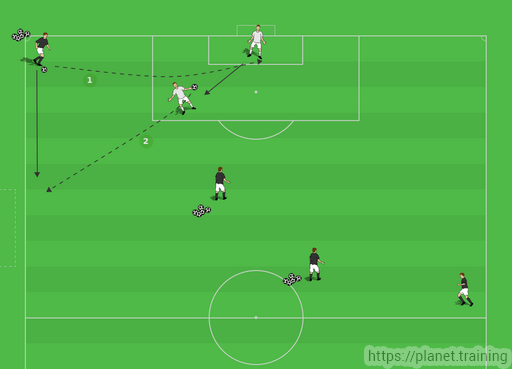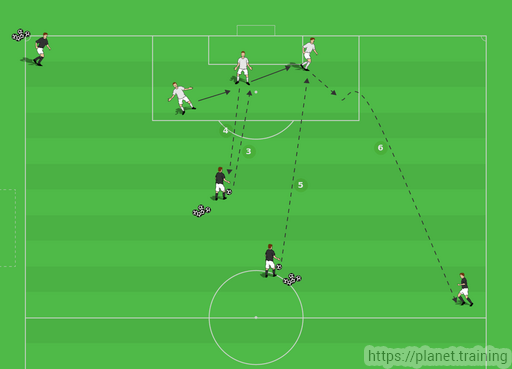By Scott Housden -
Once the goalkeeper is in control of the ball, there is nothing that frustrates not only the goalkeeper but also the rest of the team more is losing the ball through bad technique or a lack of concentration or vision. In the modern day game, distribution is an area where quality goalkeepers are expected to keep possession of the ball when kicking or throwing. The game demands that goalkeepers are able to play with both feet and are able to pass with accuracy, as well as knowing when and where to use the correct type of distribution. The drill outlined below allows for decision making, foot distribution and hand distribution, and also communication which, is vital when distributing the ball.

Set Up
• Goalkeeper starts ready to deal with a cross from the server out wide. The server crosses the ball for the goalkeeper who collects.
• The goalkeeper then moves quickly to the edge of the penalty box (during this time the same server now becomes the full back and starts to run up the sideline ready to receive the ball from the goalkeeper in order to commence a counter attack
• The goalkeeper overarm throws the ball to the full back, communicating with the fullback at the same time.
Coaching Points
After collecting the cross the goalkeeper need to quickly track the movement of the full back and move quickly through what would be a crowded area in order to distribute the ball
• When using the overarm throw the goalkeeper’s body must be in line with the direction that the trow is to travel with weight on the back foot. The other foot should be pointing in the direction the ball is to travel. Using a bowling action with a straight arm, the ball is released at the highest point, and in doing so the weigh now transfers to the front foot. The body weight must follow through to the ball from the goalkeeper’s feet and not their shoulders.
• Communicate quickly with the player by saying for example ‘run on to it’ or ‘travel forwards’
• Aim to throw the ball just in front of the running player.
Part 2
The goalkeeper then quickly moves centrally in order to deal with a back pass from the central defender. In this phase, the goalkeeper must make a timely decision to play the ball first time back to the central defender as an attacker is running towards the goalkeeper on an angle from the right hand side (imaginary)

Coaching Points
• The goalkeeper must move quickly across and backwards slightly in order to receive a back pass form the second server (central defender).
• In this scenario a first time pass must be played so composure and control will help the goalkeeper in deciding how to best distribute the ball to the defender.
• Prior to the ball being played the goalkeeper must communicate with the defender and request that the ball be played to the foot of their choice (bearing in mind the quickly moving imaginary attacker) by calling ‘keeper’s on, left foot’ and also by showing which side they want the ball played to by raising their left hand open palmed from the side of their body.
• The goalkeeper must play a first time pass back to the server whilst communicating with them at the same time by saying for example; ‘time, turn out’
Part 3
For the third part of this drill, the goalkeeper must move across the area again to receive a longer pass from server 3. Here the goalkeeper is not under pressure from on rushing attackers and so can take two touches before playing a long ball to the winger hugging the touchline.
Coaching Points
• The first touch should be out of the goalkeeper’s feet, using side foot control, allowing the goalkeeper’s next touch to bring the ball forward (as they are not under pressure) and has time and space to play the ball long with height to the winger.
• Clear concise communication to the winger by saying for example ‘come to’
After each complete circuit rotate the goalkeepers, with each goalkeeper performing the drill 3-4 times.
Progression
Add mannequins in passing channels or close to the servers to ensure accuracy of the passes from the goalkeeper.
Add actual attackers to run after back passes and pressure the goalkeeper.
Encourage the goalkeeper to use their weaker hand for throwing and weaker foot for kicking.
By Scott Housden
Scott is both a UEFA ‘B’ and UEFA ‘B’ Goalkeeping Coach and holds a Masters in Sports Management. He has been a goalkeeper coach in professional football in the UK and Australia at First Team, Academy and Women’s levels. He currently runs a Goalkeeper Academy in the Western Suburbs of Brisbane, Australia.


